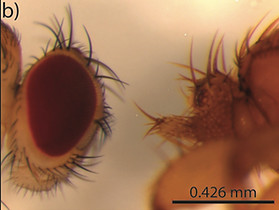

“The joy of discovery is certainly the liveliest that the mind of man can ever feel”
- Claude Bernard -
Evolution of Bioluminescence

photo: Sonke Johnsen
Light production was once thought to be a rare phenomenon among organisms, but is now frequently observed in communication, feeding, and defense. Bioluminescene is particularly observed in the deep ocean, where down-welling light is limited. By investigating the molecules involved in bioluminescence, the lab aims to understand the role of photosensitivity in bioluminescent displays and the evolutionary origins of bioluminescence in crustaceans.
Molecular Evolution of Light Detection

Visual pigments, composed of an opsin protein covalently bound to a chromophore, are sensitive to specific wavelengths of light and initiate phototransductive cascades. Opsins are an integral part of phototransduction and have rapidly diversified in some organisms, yet remain highly conserved. Not all opsins are involved in vision, and the functions of many others are not yet fully understood. One of the focuses of the lab is on understanding the evolution and functional diversification of opsins, particularly in crustaceans, using molecular techniques and comparative evolutionary structure-function studies.


Evolution of Eye Loss
The evolution of eye loss in subterranean, deep sea and nocturnal habitats has fascinated biologists since Darwin wrestled with it in On the Origin of Species. This phenomenon appears consistently throughout the animal kingdom, in groups as diverse as crustaceans, salamanders, gastropods, spiders and the well-known Mexican cave fish. The nature, extent and evolutionary processes behind eye loss, however, remain elusive.
Projects in the lab aim to understand the process of eye reduction and loss by integrating phylogenetics, comparative anatomy, ecology, and molecular studies of diverse arthropod species.

photo: Mike Bok
Evolution and Development of Sensory System Complexity
Not all eyes are created equal. Those of the stomatopod are independently mobile, tripartite, and have up to 16 spectrally different photoreceptor types, and as many as 33 different expressed opsins. The Porter Vision Labs is integrating information from electrophysiology, molecular studies, and phylogenetics in order to understand how these complex visual systems work, and how stomatopods see the world.
